I just like this picture.

I just like this picture.

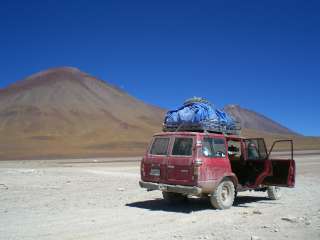 Our last day in Chile was our first day in Bolivia, which might as well be known as The Day of Extremes. We booked ourselves on a 3-day trip from San Pedro de Atacama to Uyuni through some of the strangest, and most beautiful landscape in a pretty harsh climate. The first day out, we crossed the border dressed for heat; this was a mistake. The wind whipping across the high altitude desert was icy cold and even the sun didn’t provide much warmth. We quickly dug out our sweaters and jackets and even then, we were chilly with each exit from the truck.
Our last day in Chile was our first day in Bolivia, which might as well be known as The Day of Extremes. We booked ourselves on a 3-day trip from San Pedro de Atacama to Uyuni through some of the strangest, and most beautiful landscape in a pretty harsh climate. The first day out, we crossed the border dressed for heat; this was a mistake. The wind whipping across the high altitude desert was icy cold and even the sun didn’t provide much warmth. We quickly dug out our sweaters and jackets and even then, we were chilly with each exit from the truck.
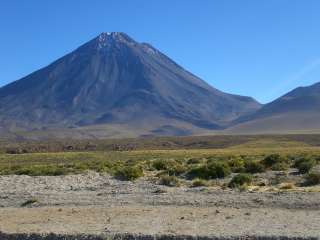 However, with the arid cold came some extraordinary features. We drove past Volcan Licancabur, which I think last erupted in 2006 (?), and this is where we started feeling the altitude. It started with a bit of a headache, sort of like a dehydration headache, which got progressively worse as we climbed to 4800m. after lunch. We spent the night at 4300m. and each time I rolled over in bed, I was short of breath. At least this will be a good warm-up for Cusco (3600m.) and Macchu Picchu (2800m.).
However, with the arid cold came some extraordinary features. We drove past Volcan Licancabur, which I think last erupted in 2006 (?), and this is where we started feeling the altitude. It started with a bit of a headache, sort of like a dehydration headache, which got progressively worse as we climbed to 4800m. after lunch. We spent the night at 4300m. and each time I rolled over in bed, I was short of breath. At least this will be a good warm-up for Cusco (3600m.) and Macchu Picchu (2800m.).
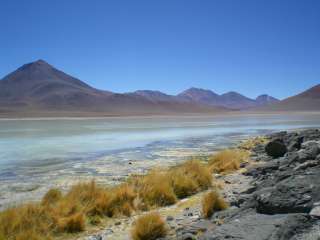 We stopped at several lakes throughout the journey, but some of the nicest pictures we got were of Laguna Verde, green from the copper in the lake’s sediment. Amazingly, many of the lakes in the area are home to pink flamingos. I somehow thought they only liked hot climate but they were feeding in abundance at several stops. Apparently, it’s the red colour of the tiny shrimps that they eat that pinks them up.
We stopped at several lakes throughout the journey, but some of the nicest pictures we got were of Laguna Verde, green from the copper in the lake’s sediment. Amazingly, many of the lakes in the area are home to pink flamingos. I somehow thought they only liked hot climate but they were feeding in abundance at several stops. Apparently, it’s the red colour of the tiny shrimps that they eat that pinks them up.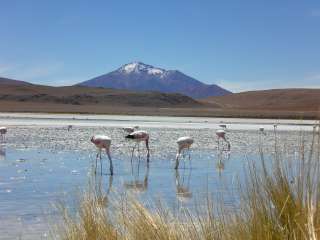
At lunch on the first day, we stopped at a thermal pool which looked out into the scrubby desert. This was our first bath in a year and felt brilliant- especially because we knew there would be no hot shower for a couple of days. 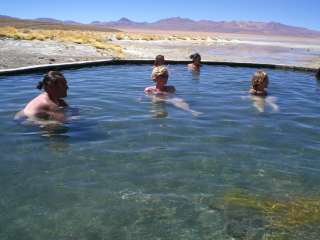
 Not so far from the thermal pool was a field of geysers and steam vents. Unlike other geysers I’ve visited, this one had no warning signs or barriers and we could, if we had wanted to, get quite close to the pits of boiling mud. We heard from another guy on our tour that a tourist fell into one of the 85C pits last year and, though they pulled him out alive, he only lasted another four hours. Our visit was highly uneventful.
Not so far from the thermal pool was a field of geysers and steam vents. Unlike other geysers I’ve visited, this one had no warning signs or barriers and we could, if we had wanted to, get quite close to the pits of boiling mud. We heard from another guy on our tour that a tourist fell into one of the 85C pits last year and, though they pulled him out alive, he only lasted another four hours. Our visit was highly uneventful.
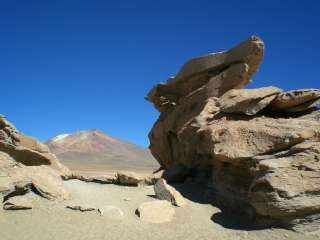 One of the last stops before the piece de resistance of the trip – the Salar de Uyuni – was a field of marvelously eroded Dali-esque rocks. The result of centuries of wind erosion, these rocks became sculptures against a backdrop of brilliantly blue sky and red-coloured mountains. The area had a strangely Mars-ish feeling about it with wide rocky plains and distant, sometimes shimmering mountains. Incredible, really.
One of the last stops before the piece de resistance of the trip – the Salar de Uyuni – was a field of marvelously eroded Dali-esque rocks. The result of centuries of wind erosion, these rocks became sculptures against a backdrop of brilliantly blue sky and red-coloured mountains. The area had a strangely Mars-ish feeling about it with wide rocky plains and distant, sometimes shimmering mountains. Incredible, really.
However, even these most amazing of extreme landscapes paled in comparison to the largest salt lake in the world…
After waiting for three hours for our Landcruiser to be repaired, we finally headed into the white plain that extended from our salt hotel to well beyond the horizon.  The Salar de Uyuni is highest and largest salt lake in the world with an area of 12,000 sq km at an altitude of 3650 meters. It´s more than double the size of the salt lake in Utah. The smooth plain was a relief from the gravel ruts that passed for roads during the previous two days. Trucks race across the salt at highway speeds without rattling our teeth or knocking our heads against the ceiling. To protect from snowblindness, sunglasses are a necessity for all except the drivers who seem immune or possibly half blind already.
The Salar de Uyuni is highest and largest salt lake in the world with an area of 12,000 sq km at an altitude of 3650 meters. It´s more than double the size of the salt lake in Utah. The smooth plain was a relief from the gravel ruts that passed for roads during the previous two days. Trucks race across the salt at highway speeds without rattling our teeth or knocking our heads against the ceiling. To protect from snowblindness, sunglasses are a necessity for all except the drivers who seem immune or possibly half blind already.
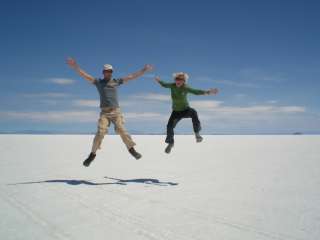 The blinding white landscape spawned creativity for many of the tourists who jumped, danced, walked on water and distorted perspective in hundreds of photographs and we were no exception. During the wet season the dry plain is covered with several inches of water that creates a perfect reflection of the sky, but we only saw a small pond.
The blinding white landscape spawned creativity for many of the tourists who jumped, danced, walked on water and distorted perspective in hundreds of photographs and we were no exception. During the wet season the dry plain is covered with several inches of water that creates a perfect reflection of the sky, but we only saw a small pond.
 Standing in the plain, islands of rock appear to float above the horizon because of the heat rising off the plain. We stopped at a relatively small island called Incahuasi (Inca’s Hope) to play in the salt and climb the rocks. The island is covered in large cacti and all the tourist necessities, such as a restaurant and gift shop.
Standing in the plain, islands of rock appear to float above the horizon because of the heat rising off the plain. We stopped at a relatively small island called Incahuasi (Inca’s Hope) to play in the salt and climb the rocks. The island is covered in large cacti and all the tourist necessities, such as a restaurant and gift shop.
I would never have imagined that such a simple landscape could be so beautiful and captivating.
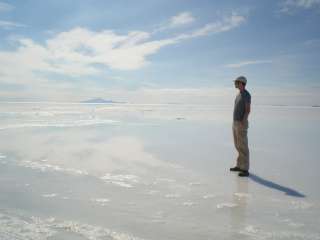
 They say that this valley, just outside San Pedro de Atacama in Chile, is supposed to have rather a moonscape appearance. The guidebook says that at sunset, the landscape changes colours to become sort of a pinky-orange hue which is reminiscent of the moon. I don’t know that the moon is supposed to be very pink or orange but we did take the trip up there at sunset. It was something worth seeing, though I’d say it was more Mars than moon.
They say that this valley, just outside San Pedro de Atacama in Chile, is supposed to have rather a moonscape appearance. The guidebook says that at sunset, the landscape changes colours to become sort of a pinky-orange hue which is reminiscent of the moon. I don’t know that the moon is supposed to be very pink or orange but we did take the trip up there at sunset. It was something worth seeing, though I’d say it was more Mars than moon.
Personally, I think this place looks more like the moon. I forget which valley it is, though…

What follows is my own personal collection of relative oddities about Chile:

Busking. Rather than the usual forms of busking for money (singing, instrument playing, etc.) we witnessed a new form of an old trade: juggling for money in the intersections. Often, we saw young guys performing some exceptional juggling acts for the cars waiting at stop lights, and then take a bow before collecting donations. It’s a pretty good show if you’re sitting at an outdoor cafe near an intersection.
Advertising. Speaking of intersections, in some of the really heavy traffic zones, there were people that were hired to carry out oversize banners into the street for the cars waiting for the light to change. One on each side, they would trudge out into the crosswalk and display the ad for about 20 seconds before moving back to the sidewalk. On a good day, this would be a pretty dull occupation; standing in the sun on a hot day wouldn’t make it any better.
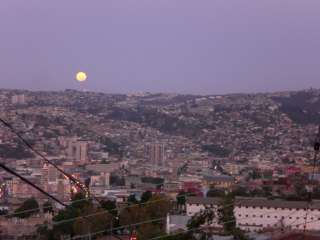
Pisco. This is a brandy-like drink whose origin is a major point of contention between Chile and Peru. Each country insists it is the home of this fiery liquor but neither can conclusively prove it so the battle rages on. It’s not just a mild disagreement, either; apparently, it’s quite a serious issue. We tried a couple of varieties of the Chilean pisco: pisco sour (imagine pale brandy with lemon juice and sugar) and piscola, a blend of pisco and Coke. Chileans drink these as aperitifs, but after two of either, we were under the table.
Coca-Cola. Why is it that so many people enjoy a Coke with dinner? I mean, it’s no secret that people in North America drink a lot of pop, but it seems a trifling amount compared to our South American counter-parts. Coke Zero is huge here.
PDA. People in Asia would be shocked to witness the public displays of affection in Chile. In a restaurant for dinner one evening in Santiago, we were the only couple not making out at the table, no exaggeration. And it went on for so long, it was pretty distracting from eating.

Fast Talking. Just when I was starting to get used to Argentine castellano, we arrived in Chile where they speak in a blur and drop letters off of some words. “Gracias” becomes “gracia” and “por favor” becomes “po favo”. Even the Argentines think the Chileans speak too fast.
Queuing. An interesting phenomenon that we’ve witnessed only in Chile and Argentina is the queuing for the bus. Lines of patient people snake along the sidewalks waiting for the buses to arrive and then – so organized! – people climb aboard one by one until it is full to capacity. Never did we see anyone budging in line or crowding the doors. Amazing.
Showers. This is new: instead of automatic, continuous-flow water heaters that start when up the faucet is turned on, the heaters for some Chilean showers must be manually ignited beforehand. In other words, they use gas heaters that one must light like a furnace with a pilot light each time one wishes to have a hot shower. (Speaking of odd showers, we’re in Bolivia now and this is the first instance of the shower-head-mounted electric water heater I’ve seen. Our guidebook says to wear rubber-soled shoes in the shower to avoid unpleasant shocks.)
The perplexing persistence of Nescafe. How does this product survive?! It is an insult to real coffee and yet its existence is ubiquitous. I’ve actually given up coffee and have taken to tea so as to avoid the risk of ordering coffee and getting sludgy Nescafe.
More than any other place we’ve been, Chile seems to be an open canvas for graffiti artists. In fact, I even saw posters for sale picturing the “great works” of graffiti during the military rule of the country; those graphic criticisms would’ve been more than a little risky to paint at the time.
The graffiti we came across was useful to us in that we were able to practice reading Spanish, albeit with several “colloquialisms” which went beyond our language classes. Still, there was a definite artistic flair to the things we saw, more than just the average tagging. Anyhow, these were some of my favourites:
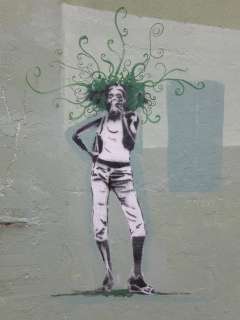
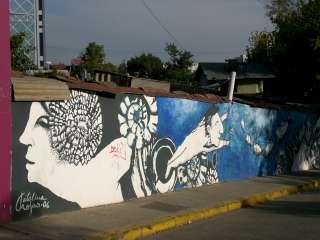

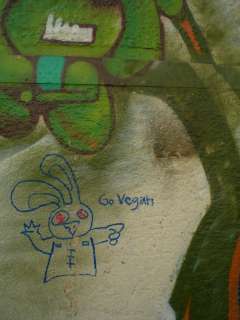
 I am a huge fan of the set lunch menu. If ever we come across one on our travels, especially if it is of the French variety, I insist on making an effort to give it a go. Nine times out of ten, it is a delicious lunch for a great value, usually three courses with a drink and maybe even a coffee thrown in at the end. If we´re lucky, two of us can get a big meal for under $20. Plus, I have a theory that these lunches are even more delicious if there is a crowd of people in the restaurant and a queue at the door.
I am a huge fan of the set lunch menu. If ever we come across one on our travels, especially if it is of the French variety, I insist on making an effort to give it a go. Nine times out of ten, it is a delicious lunch for a great value, usually three courses with a drink and maybe even a coffee thrown in at the end. If we´re lucky, two of us can get a big meal for under $20. Plus, I have a theory that these lunches are even more delicious if there is a crowd of people in the restaurant and a queue at the door.
Twice in recent weeks we have come across dreamy set menus. The first was in the antique-y, bohemian barrio of San Telmo in Buenos Aires. We were actually looking for some other restaurant with a set menu and happened across a cafe named something like ¨Via Via¨. Anyway, it was crammed full of suits but we managed to snag one of the tables and ordered “dos, por favor.” This one was only two courses: roasted quarter of a chicken, salad and rice with home-made ice cream for dessert. Simple enough menu for a late lunch but it was hot and tasty and left us full enough that we didn´t need to eat again that day.
For the past two days, we have eaten lunch at the same cafe in Valparaiso, Le Filou de Montpellier.  Yesterday, it was a crepe filled with bechemel and cheese to start, then roasted chicken with this fantastic mushroom reduction sauce and then profiteroles with ice cream and chocolate sauce. It´s making my mouth water just to remember it. With wine, it was $22 dollars and there was a queue of people at the door waiting for our table. Hurrah! The meal today was a tarte of tomato, eggplant and camembert, slow-cooked beef in wine sauce with a gratin of potatoes and then Ile Flottant for dessert. No wine this time (thanks to a pisco-induced hangover today) but still, the best-value lunch menu I can remember having had. If we were staying here longer, I can almost guarantee that we´d be going back at least every other day. As it is, we´ll be going back tonight to Alegretto for – arguably – the best pizza I´ve ever had. We may not be eating classic comida Chilena, but I´m digging the food here.
Yesterday, it was a crepe filled with bechemel and cheese to start, then roasted chicken with this fantastic mushroom reduction sauce and then profiteroles with ice cream and chocolate sauce. It´s making my mouth water just to remember it. With wine, it was $22 dollars and there was a queue of people at the door waiting for our table. Hurrah! The meal today was a tarte of tomato, eggplant and camembert, slow-cooked beef in wine sauce with a gratin of potatoes and then Ile Flottant for dessert. No wine this time (thanks to a pisco-induced hangover today) but still, the best-value lunch menu I can remember having had. If we were staying here longer, I can almost guarantee that we´d be going back at least every other day. As it is, we´ll be going back tonight to Alegretto for – arguably – the best pizza I´ve ever had. We may not be eating classic comida Chilena, but I´m digging the food here.
 It’s no secret that the people of Argentina and Chile adore their meat. It is available everywhere, on every menu, in several different forms, served day and night, and almost always grilled to well done. I wouldn’t want to be an animal in South America as it’s only a matter of time before you end up on a menu.
It’s no secret that the people of Argentina and Chile adore their meat. It is available everywhere, on every menu, in several different forms, served day and night, and almost always grilled to well done. I wouldn’t want to be an animal in South America as it’s only a matter of time before you end up on a menu.
At a grocery store in Mendoza on a Saturday, a riot* of people had gathered around a meat counter that was struggling to keep up with the orders being shouted to the back. Meat is serious business and a good butcher, we’re told, is highly coveted and his address is held close to the chest. In Argentina, I thought I had reached the limit of my carnivorous consumption, but I was dead wrong; that was just the beginning.
Today’s lunch in the pretty Bellavista neighbourhood of Santiago consisted almost entirely of meat. We ordered the parrilla special for 2 and what landed on our table would’ve easily served six. Imagine a 9×9” square casserole dish filled to heaping with 2 big, grilled pork chops, 1 large, grilled steak, 2 blood sausages, 1 spicy chorizo sausage, 2 huge, grilled chicken breasts, and 2 large, boiled potatoes. That was lunch. There was some thyme on the chicken, and there was a salt shaker on the table, but that was all the seasoning that appeared. Luckily, a stray dog sleeping the shade of the next table was only too happy to eat most of what remained on my plate while the waiter wasn’t looking.
*Speaking of riots, it turns out that there was some serious rioting in Santiago the day we arrived. It was the annual Day of The Young Commbatents riot/protest staged in memory of the 1985 student riots during which many students were killed. This year’s anniversary protest was aggravated, we’re told, by some discontent with recent public transportation changes. At any rate, our afternoon arrival at the bus station, metro ride and walk through part of the downtown area was entirely uneventful; we didn’t sense the slightest whiff of unease. When we arrived at our hostel, one of the guys staying there asked, “What are the streets like out there- is it madness?” Of course we didn’t know what he was talking about and it was then that the hostel worker said that yes, there were riots, and that perhaps we should stay in the hostel that evening. The next morning, the news showed this. Santiago makes two cities now that we have visited while riots were in progress and we didn’t even know it. (The other was Budapest in September.) Stupid foreigners.

We found a small premium wine tour with Ampora Tours to the Uco Valley, the supposed “next Napa Valley” and home to the highest vineyards in the world at 1,100 to 1,300 meters. The sandy soil, sunny days, cool nights, lack of rain, and abundant spring water all create perfect conditions for great grapes with concentrated sugars and thick skins. After picking up the three other tourists we visited three vineyards of different sizes with our guide.
The tour was nearly continuous hilarity from the beginning and wine only added to the Canadian humour. Upon finding out the other tourists in the group were staying at the Park Hyatt, we started hypothesizing who would stay at this elite bastean of elegant class. I guessed Americans and Janet guessed Germans. Both wrong: two youngish Canadian women, Sharon and Linda from Vancouver, travelling on their oil and gas money. They vowed revenge if we published this picture of them. So be it.

The first vineyard, Estancia Ancon, was the smallest vineyard with a production of 90,000 bottles. The Grande Reserve de la Familia blend of cabernet sauvignon, malbec and pinot noir, a limited edition of 6,000 bottles, was our favorite wine of the day, although our palettes were still fresh at the time. The atypical blend had a pleasant smoothness from the pinot noir and oak. The property’s villa can also accommodate tourists for an undisclosed sum.
 Andeluna, the second vineyard, was a little bigger. The suburban-country tasting room was warm, though a little contrived. We tried five wines with the 2005 Malbec and the 2003 Pasionado Blends being our favorites.
Andeluna, the second vineyard, was a little bigger. The suburban-country tasting room was warm, though a little contrived. We tried five wines with the 2005 Malbec and the 2003 Pasionado Blends being our favorites.
The last vineyard was O. Fournier. The owners told the architects that visitors should either hate it or love it, but never forget it. The ominous concrete structure fulfilled that mandate; it kind of looks like an airport terminal. To avoid pumping the wine, the lowest level is 20 meters underground. Whole grapes are crushed at the top level, then slide down to the fermentation vats on the next level, and then are aged in oak barrels on the last level. We toured the cellar on catwalks where we also viewed enourmous pieces of art from a local artist.
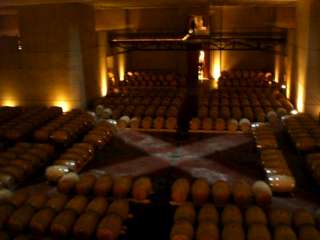

A highlight of the tour was the four course lunch at the winery’s by-appointment-only-restaurant. A colourful trio of warm soups—potato, pumpkin with pepper and greensquash with spring onion—were served in shot glasses and followed up with a few simple treads of julienned peppers and eggplant with oil and salt. We were surprised to find the Malbec held up to the red wine vinegar in the salmarejo, a cold gazpacho-like soup, which followed. Alfa Crux, a wine we tasted at Vines of Mendoza, accompanied the requisite beef entree. The dining room’s six meter high windows were intended to provide grand views of the Andes, but instead the clouds provided a white backdrop which only partially cleared.
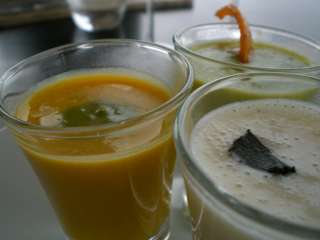
After a day of wine we were noisely cracking jokes and laughing and the two Canadian women setting the pace. As the only male in a party of six, I couldn’t offset the natural tendency of the drunk women to get rowdy and talk about men. Somehow, one of the owners’ father at the next table managed to fall asleep over the ruckus at the next table. Fortunately, the ladies directed most of their interest to the driver, the waiter and the security guard, who one hoped would require sexual favors in place of a lost receipt.
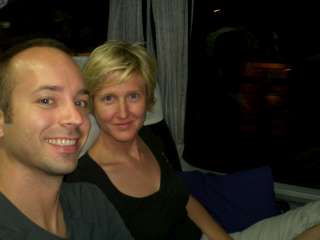 Thanks to fellow Calgarians we had met in Vietnam, we had been looking forward to the bus to Mendoza for several months and the recent days of plane travel had made the idea even more appealing. The long, straight and flat roads of Argentina and their low gasoline costs make long-distance bus travel ideal. Most buses here are double-deckers with most of the seating on the upper deck and a toilet on the lower deck. Semi-sleeper seats recline 140 degrees and sleeper seats recline 160 degrees. For our 12 hour journey from Buenos Aires, we opted for the Executive Class with large leather seats that recline a full 180 degrees to create a small bed. These are only remotely reminiscent of the sleeper buses of India with their make-shift beds, insect infestations and rattling roads.
Thanks to fellow Calgarians we had met in Vietnam, we had been looking forward to the bus to Mendoza for several months and the recent days of plane travel had made the idea even more appealing. The long, straight and flat roads of Argentina and their low gasoline costs make long-distance bus travel ideal. Most buses here are double-deckers with most of the seating on the upper deck and a toilet on the lower deck. Semi-sleeper seats recline 140 degrees and sleeper seats recline 160 degrees. For our 12 hour journey from Buenos Aires, we opted for the Executive Class with large leather seats that recline a full 180 degrees to create a small bed. These are only remotely reminiscent of the sleeper buses of India with their make-shift beds, insect infestations and rattling roads.
Upon departure, the first order of business was to play bingo for a bottle of wine. Our fabulously friendly bus attendant read numbers while I tried to translate the numbers as quickly as possible. Unfortunately we lost and a pregnant woman sheepishly claimed her prize. Later we were fed a sleep-inducing three course dinner with beef and a couple of glasses of free wine. We could hardly stay awake through the first movie and slept soundly through the second.
We’re now actually looking forward to our 24 hour Executive-seat bus ride in Chile from Valparaiso to San Pedro de Atacama, especially since we booked the front row of the top deck for ideal views of the passing Andean landscape.